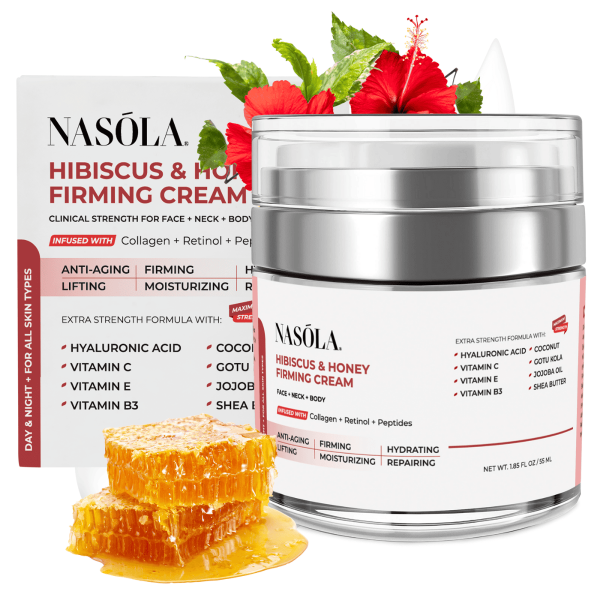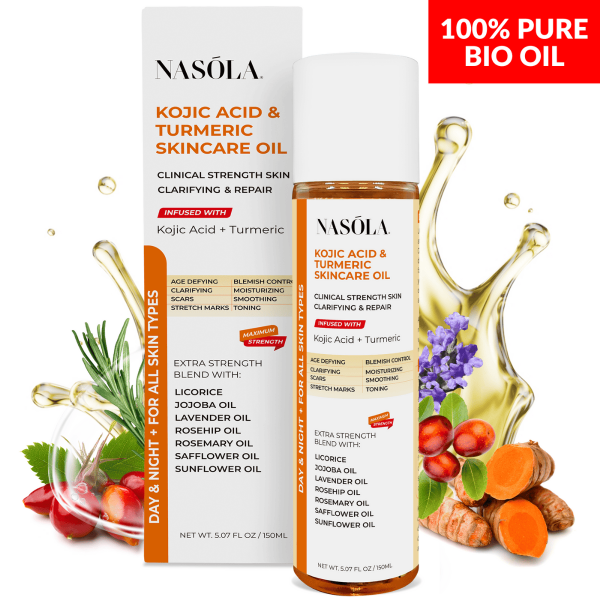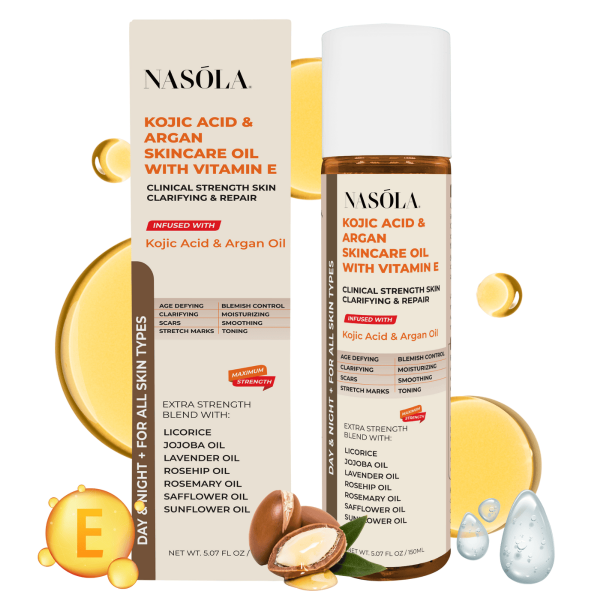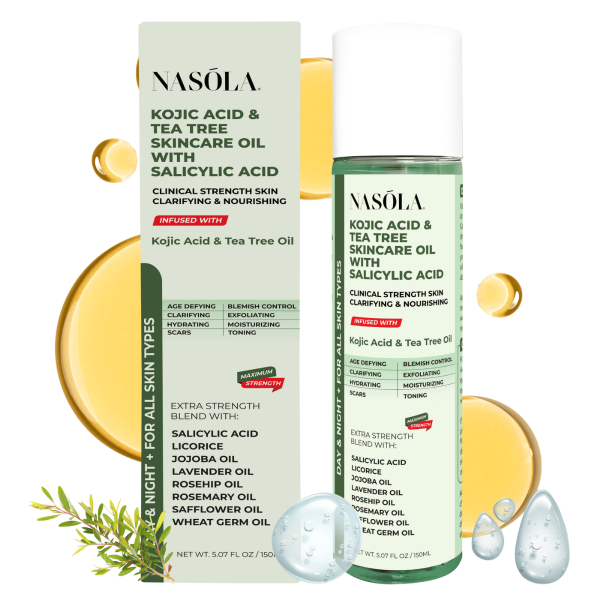If you’ve ever stared at your reflection and thought, “When did that line get there??”—you’re not alone. Aging skin is a journey, isn’t it?
One day you’re glowing and the next… a little less radiant, a little more textured. Fine lines, dryness, sudden dullness—they sneak up on you.
But the best face oil for aging skin? That doesn’t just exist. It works. And it works hard.
Here’s where things start looking up. Face oils packed with ingredients like kojic acid, turmeric, tea tree, and argan aren’t just trendy—they’re transformative.
I’ve been there, reading labels under bad bathroom lighting, praying for something that actually delivers. If that sounds familiar, you’ll want to stick around.
In this blog, we’ll get real about picking the right oil. You’ll discover powerhouse ingredients, expertly paired formulations (you’ll LOVE Nasola’s offerings), and exactly how to use them.
It’s time to reclaim your radiance—and YES, it’s possible.
- What is the Best Face Oil for Aging Skin?
- Best Facial Oil for Aging Skin: Top Picks to Consider
- Kojic Acid and Its Anti-Aging Benefits
- How to Incorporate the Best Face Oil for Aging Skin into Your Routine
- How to Choose the Best Face Oil for Aging Skin Based on Your Skin Type
- Natural Oils vs Synthetic Anti-Aging Solutions: What’s Better for Aging Skin?
- Extra Glow: Unique Ways to Use the Best Face Oil for Aging Skin
- Conclusion
- Frequently Asked Questions
What is the Best Face Oil for Aging Skin?
When we talk about the best face oil for aging skin, we’re really looking at one thing—results. But it’s more than just smoother skin.
A great face oil hydrates, boosts elasticity, supports the moisture barrier, and addresses pigmentation. Think of it like your skin’s nighttime bestie.
That’s why oils like argan and turmeric—with natural antioxidants and anti-inflammatory magic—are taking center stage. Turmeric brightens, kojic acid lightens, and together?
Game-changer for dull, tired skin. One superstar that checks all the boxes is the Nasola Kojic Acid Turmeric Skincare Bio Oil. Seriously, it’s like sunshine bottled up—radiant skin in a few drops.
Benefits of Turmeric and Kojic Acid
Turmeric and kojic acid don’t just whisper to your fine lines—they give them notice.
- Brightens dull, lifeless complexions.
- Fades dark spots and pigmentation over time.
- Reduces redness from sensitivity or aging.
- Delivers anti-inflammatory support to keep mature skin calm.
Why Face Oils Work Better Than Creams for Some
Face oils absorb deeper, giving your skin long-lasting moisture and nourishment. Mature skin tends to lose natural oils, making oils more effective than some traditional moisturizers.
- Mimic skin’s natural sebum.
- Penetrate deeper than water-based creams.
- Deliver nutrients directly without unnecessary fillers.
- Ideal for dry climates or winter skin care.
Best Facial Oil for Aging Skin: Top Picks to Consider

If I had a dollar every time I was overwhelmed by face oils—I could fund my entire skincare stash. But finding the best facial oil for aging skin isn’t just about hype—it’s about formulas that work.
Enter: Nasola Kojic Acid Argan Skincare Bio Oil. This oil blends powerhouse ingredients (hello, kojic acid AND argan oil) for a next-level glow.
With rich fatty acids, vitamin E, and anti-aging nutrients—trust me, it’s the kind of product your future self will thank you for. And it’s light! It doesn’t clog pores or sit heavy—just moisturized, bouncy skin.
Benefits of Argan Oil in Aging Skin
Let’s talk about argan oil. This one’s a treasure.
- Intensely hydrates without heaviness.
- Promotes elasticity with rich vitamin E.
- Reduces wrinkle depth with daily use.
- Reinforces the skin barrier, preventing moisture loss.
Beauty Tip: When to Apply Oils for Maximum Benefit
Using your facial oil at the wrong step can cancel all those good benefits.
- Always apply to damp skin for better absorption.
- Use at night when your skin’s in repair mode.
- Follow with firming cream to seal in benefits.
- Pair with hydrating serums for deeper penetration.
Kojic Acid and Its Anti-Aging Benefits
Let’s get one thing straight—kojic acid isn’t just about brightening. It’s about turning back time (well, kind of). Kojic acid is a naturally derived powerhouse for tackling age spots, uneven tone, and sun damage.
And Nasola mastered its use in the Kojic Acid Tea Tree Skincare Bio Oil with Salicylic Acid.
This oil is impressive. You don’t often find something that balances blemish-prone aging skin, turns over dull skin cells, and doesn’t leave you drier than the Sahara.
Pairing Kojic Acid with Tea Tree and Salicylic Acid
You want clarity + glow? This trifecta delivers.
- Tea tree calms and clears acne-prone areas.
- Salicylic acid unclogs pores and removes dull cells.
- Kojic acid works behind the scenes to fade spots.
- Seamless for oily or sensitive mature skin.
What Skin Types Benefit Most From Kojic Acid Oils?
Aging skin doesn’t mean oil-free skin. Understanding your type helps maximize kojic acid usage.
- Oily skin: gets balanced without over-drying.
- Combo skin: receives targeted help with hyperpigmentation.
- Mature acne-prone: sees fewer breakouts and scars.
- Sensitive types: benefit from kojic’s gentle pigment-fading over time.
How to Incorporate the Best Face Oil for Aging Skin into Your Routine
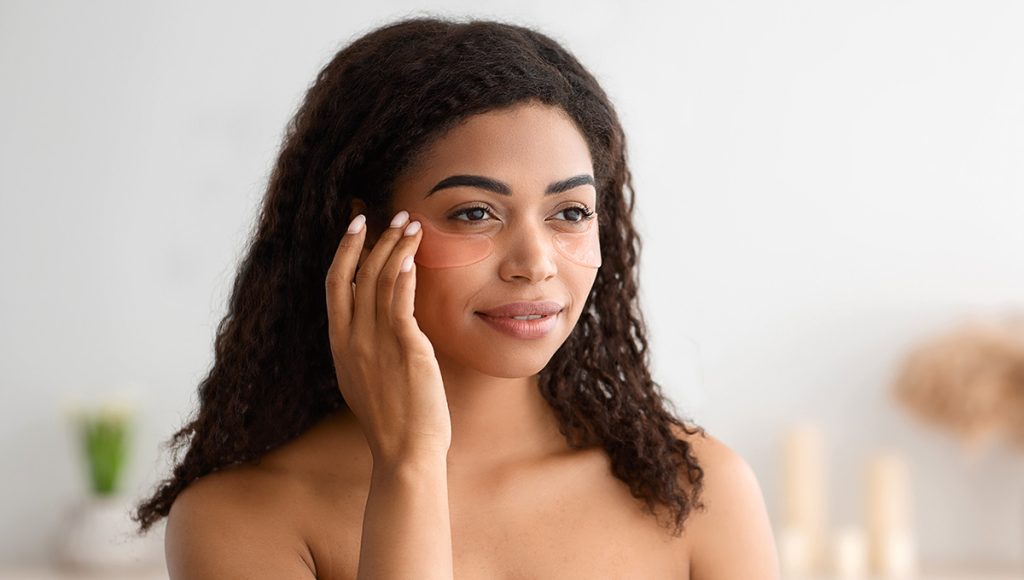
I get asked this all the time—“Where does my oil go??” The confusion is real. Incorporating the best face oil for aging skin isn’t complicated, but a little routine planning makes a big difference.
Whether you’re layering with serums or topping it with cream, the goal is nourishment AND sealing in hydration. I personally love pairing oil use with Nasola’s Hibiscus and Honey Firming Cream at night.
They’re like…the dream team.
Benefits of Hibiscus in Firming Creams
This flower is more than garden pretty.
- Acts as a natural AHA to gently resurface texture.
- Tightens and lifts papery skin with humectants.
- Minimizes dry patches and flakiness.
- Revives dull, uneven skin tones over time.
Oils Before or After Moisturizer?
This debate ends here. Ready?
- Apply oils AFTER water-based serums.
- Moisturizers come after oils to lock everything in.
- At night, use creams last for more overnight hydration.
- In mornings, layer sunscreen over oil to seal and protect.
How to Choose the Best Face Oil for Aging Skin Based on Your Skin Type
Listen—your skin’s not just “aging.” It’s also dry, oily, combo, maybe a little reactive under pressure. Don’t just grab what your best friend uses.
Tailor it. With choices like Nasola’s Kojic Acid Turmeric Skincare Bio Oil or Nasola Kojic Acid Argan Skincare Bio Oil, you’ve got options.
For Dry or Mature Skin: Nasola Argan Oil Wins
Nourishing meets elegant.
- Deeply hydrating without heaviness.
- Calms flaky, rough areas quickly.
- Boosts elasticity with fatty acids.
- Minimizes fine lines with repeated use.
For Acne-Prone or Oily Skin: Tea Tree Reigns
Yes, aging skin can break out too.
- Combats clogged pores with salicylic acid.
- Keeps bacteria at bay with tea tree.
- Fades spots left behind by acne.
- Lightweight, non-comedogenic for effortless wear.
Natural Oils vs Synthetic Anti-Aging Solutions: What’s Better for Aging Skin?

Let’s be real—retinol isn’t for everyone. It’s powerful, no doubt, but can also bring redness, peeling, or worse. When aging skin is already a little dry and sensitive, natural oils like turmeric, jojoba, or argan offer plant-powered alternatives.
The good news?
They work. Especially when paired with creams like Nasola Hibiscus and Honey Firming Cream. Soothing and strengthening at once.
Combining Face Oils with Plant-Based Creams
Don’t sleep on plant pairings!
- Hibiscus lifts while oils hydrate.
- Natural antioxidants nourish long-term.
- No harsh purging or tight-feeling discomfort.
- Supports barrier repair and pigment reduction simultaneously.
Are Synthetic Products Bad for Aging Skin?
Not all synthetics are evil. But be cautious.
- Many include drying alcohols or fragrances.
- Retinoids can over-exfoliate mature skin.
- Oils are safer for sensitive, thinning complexions.
- A more holistic route means fewer surprise allergies.
Extra Glow: Unique Ways to Use the Best Face Oil for Aging Skin
Want to upgrade your game? Sometimes it’s less about what and more about how. Instead of just patting your oil and walking away, try these glow-enhancing rituals that amplify your results.
Use a Gua Sha with Facial Oils
Facial tools + oil? WOW, the difference shows.
- Promotes lymphatic drainage to reduce puffiness.
- Boosts blood flow to fuel collagen production.
- Helps oils absorb deeper, improving thirsty skin texture.
- Encourages facial muscle tone and lift.
Pair With Steam or Warm Towels
Give your skincare some spa energy.
- Opens pores for max nutrient absorption.
- Softens dead skin for improved texture.
- Helps dissolve sebum congestion gently.
- Feels downright luxurious (you deserve it).
Conclusion
You’re not just choosing skincare—you’re choosing a version of yourself. The one who says yes to slow mornings, deep hydration, and feeling good in her bare skin.
Finding the best face oil for aging skin isn’t about age. It’s about energy, health, intention.
Products like Nasola Kojic Acid Turmeric Skincare Bio Oil, Nasola Kojic Acid Argan Skincare Bio Oil, Nasola Kojic Acid Tea Tree Skincare Bio Oil with Salicylic Acid, and Nasola Hibiscus and Honey Firming Cream show what’s possible when ingredients and intention come together.
So, go glow. Start simple. Start strong. Certainly….start with oil.
Frequently Asked Questions
The best face oil for aging skin is one that hydrates, softens fine lines, and evens out discoloration. Nasola Kojic Acid Argan Skincare Bio Oil is excellent due to its kojic acid for pigment correction and argan oil to lock in moisture.
Yes, oils rich in fatty acids, antioxidants, and vitamins strengthen the skin barrier and boost elasticity. With consistent use, wrinkles soften, and skin looks more plump and youthful.
Absolutely. Daily use helps aging skin maintain moisture, softness, and glow. Apply day or night. For best results, try Nasola Kojic Acid Turmeric Skincare Bio Oil—it hydrates and brightens without being oily.
Nasola Kojic Acid Tea Tree Skincare Bio Oil with Salicylic Acid is your top pick. It controls breakouts, fades old spots, and keeps skin nourished.
Yes! In fact, layering oil with Nasola Hibiscus and Honey Firming Cream enhances its anti-aging power and locks in hydration.
Use oil after any water-based serum and before or after your moisturizer, depending on your skin’s needs. Nighttime routines usually benefit from oils Under creams for deep hydration.
Both serve different purposes. Face oils hydrate and protect the skin barrier, while serums target specific concerns. Use them together—serum first, oil second.
You might notice softness overnight, but visible brightening and firming typically show within 2–4 weeks with regular use.
Definitely. Face oils like Nasola Kojic Acid Argan Skincare Bio Oil are great for men’s skin—lightweight, easy to use, and improve texture visibly.
Yes, when used in gentle formulations like Nasola’s, kojic acid can safely brighten and fade discoloration in sensitive skin types with minimal risk of irritation.


